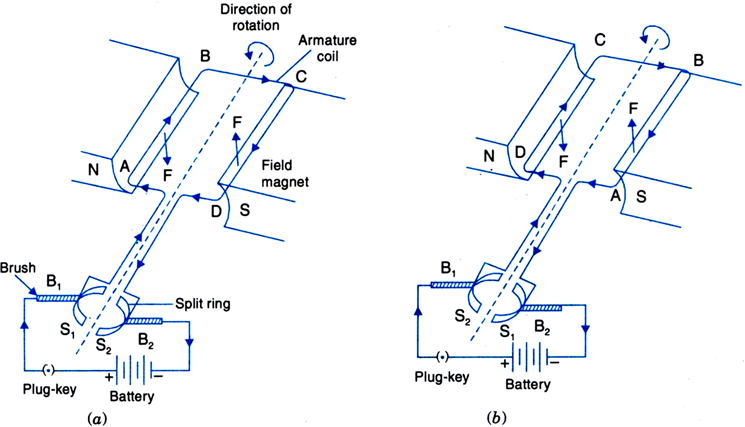(a) State Fleming’s left-hand rule.
(b) Write the principle of working of an electric motor.
(c) Explain the function of the following parts of an electric motor.
(i) Armature (ii) Brushes (iii) Split ring
The direction of the force which acts on the current carrying conductor placed in a magnetic field is given by Fleming's left-hand rule.
Fleming's right-hand rule stretch the thumb, forefinger and the central finger of the right hand mutually perpendicular to each other. If the forefinger points in the direction of the magnetic field, thumb in the direction of the motion of the conductor, then the central finger points in the direction of current induced in the conductor.
(b) Electric Motor: An electric motor converts electrical energy into mechanical energy.
Principle: It is based on the fact that when a coil carrying current is held in a magnetic field, it experiences a torque, which rotates the coil.

Construction: An electric motor consists of the following main parts:
1. Field magnet: It is a strong horse shoe type magnet with concave poles.
2. Armature: It is a rectangular coil ABCD having a large number of turns of thin insulated copper wire wound over a soft iron core.
The armature is placed between the poles of the field magnet and it can be rotated about an axis perpendicular to the magnetic field lines.
3. Split ring commutator: It consists of a cylindrical metal ring split into two halves S1and S2. The two ends A and D of the armature coil are connected to the split rings S1 and S2 respectively. As the coil rotates, the split rings also rotate about the same axis of rotation. The function of the split ring commutator is to reverse the direction of current in the coil after every half rotation.
4. Brushes: Two graphite or flexible metal rods maintain a sliding contact with split rings S1 and S2, alternately.
5. Battery: A battery of few cells is connected to the brushes. The current from the battery flows to the armature coil through the brushes and the split rings.
Working: Initially, suppose the plane of the coil is horizontal. The split ring S1 touches the brush B1 and split ring S2 touches the brush B2. The current in coil flows in the direction ABCD from the source battery, as shown in Fig.(a).
Clearly, the currents in arms AB and CD are in opposite directions. The force acting on arm AB pushes it downwards while the force acting on the arm CD pushes it upwards. Thus the armature coil alongwith the axle rotates anticlockwise. After half a rotation, as shown in Fig.(b), the split ring comes in contact with brush B2, and S2 in contact with brush B1. Therefore, the current in the coil gets reversed and flows along the path DCBA. A device that reverses the direction of flow of current through a circuit is called commutator. Thus the arm AB is now pushed up and the arm CD is pushed down. Therefore, the coil and the axle rotate half a turn more in the same direction. The reversing of the current is repeated at each half rotation, giving rise to a continuous rotation of the coil and to the axle.
Split ring acts as commutator in electric motors.






